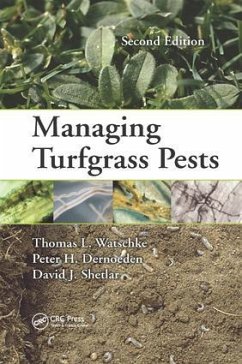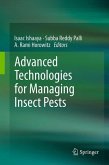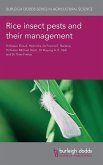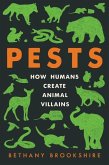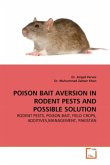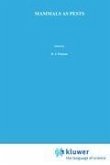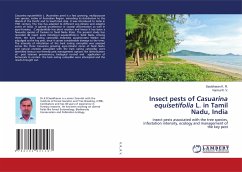- Broschiertes Buch
- Merkliste
- Auf die Merkliste
- Bewerten Bewerten
- Teilen
- Produkt teilen
- Produkterinnerung
- Produkterinnerung
Written by top turfgrass professionals, this second edition of a bestseller presents hundreds of solutions and best practices to help you manage turfgrass weeds, diseases, and insects more effectively. It explains how to integrate cultural, biological, and chemical management tactics to ensure quality and functional turf on lawns, athletic fields, and golf courses. Rather than simply relying on a pesticide solution, the authors discuss how to fine-tune cultural practices to optimize the competitiveness of your turfgrass against the pests that inevitably become part of any ecosystem.
Andere Kunden interessierten sich auch für
![Advanced Technologies for Managing Insect Pests Advanced Technologies for Managing Insect Pests]() Advanced Technologies for Managing Insect Pests113,99 €
Advanced Technologies for Managing Insect Pests113,99 €![Rice insect pests and their management Rice insect pests and their management]() Emeritus E. A. HeinrichsRice insect pests and their management253,99 €
Emeritus E. A. HeinrichsRice insect pests and their management253,99 €![Pests Pests]() Bethany BrookshirePests21,99 €
Bethany BrookshirePests21,99 €![POISON BAIT AVERSION IN RODENT PESTS AND POSSIBLE SOLUTION POISON BAIT AVERSION IN RODENT PESTS AND POSSIBLE SOLUTION]() Amjad PervezPOISON BAIT AVERSION IN RODENT PESTS AND POSSIBLE SOLUTION45,99 €
Amjad PervezPOISON BAIT AVERSION IN RODENT PESTS AND POSSIBLE SOLUTION45,99 €![Mammals as Pests Mammals as Pests]() R.J. Putman (Hrsg.)Mammals as Pests153,99 €
R.J. Putman (Hrsg.)Mammals as Pests153,99 €![Insect pests of Casuarina equisetifolia L. in Tamil Nadu, India Insect pests of Casuarina equisetifolia L. in Tamil Nadu, India]() Sasidharan K. R.Insect pests of Casuarina equisetifolia L. in Tamil Nadu, India47,99 €
Sasidharan K. R.Insect pests of Casuarina equisetifolia L. in Tamil Nadu, India47,99 €![Mite and insect pests of some important plants Mite and insect pests of some important plants]() Reham Abo-ShnafMite and insect pests of some important plants66,99 €
Reham Abo-ShnafMite and insect pests of some important plants66,99 €-
-
-
Written by top turfgrass professionals, this second edition of a bestseller presents hundreds of solutions and best practices to help you manage turfgrass weeds, diseases, and insects more effectively. It explains how to integrate cultural, biological, and chemical management tactics to ensure quality and functional turf on lawns, athletic fields, and golf courses. Rather than simply relying on a pesticide solution, the authors discuss how to fine-tune cultural practices to optimize the competitiveness of your turfgrass against the pests that inevitably become part of any ecosystem.
Produktdetails
- Produktdetails
- Verlag: CRC Press
- 2. Auflage
- Seitenzahl: 520
- Erscheinungstermin: 22. November 2017
- Englisch
- Abmessung: 234mm x 156mm x 28mm
- Gewicht: 781g
- ISBN-13: 9781138076372
- ISBN-10: 1138076376
- Artikelnr.: 50858450
- Herstellerkennzeichnung
- Libri GmbH
- Europaallee 1
- 36244 Bad Hersfeld
- gpsr@libri.de
- Verlag: CRC Press
- 2. Auflage
- Seitenzahl: 520
- Erscheinungstermin: 22. November 2017
- Englisch
- Abmessung: 234mm x 156mm x 28mm
- Gewicht: 781g
- ISBN-13: 9781138076372
- ISBN-10: 1138076376
- Artikelnr.: 50858450
- Herstellerkennzeichnung
- Libri GmbH
- Europaallee 1
- 36244 Bad Hersfeld
- gpsr@libri.de
Dr. Thomas L. Watschke is presently professor emeritus of turfgrass science at the Pennsylvania State University, where he was on the faculty for 35 years. Dr. Watschke has been honored nationally by the Golf Course Superintendents Association of America and the American Sod Producers Association, Division C-5 (ASA, CSSA) Grau Award, and has been accorded fellow status by both the Crop Science Society of America and the American Society of Agronomy. He is recognized throughout the world for his teaching and research accomplishments in weed science, plant growth regulation, and water quality. He has made presentations in France, Australia, Spain, England, Scotland, and Canada and is active in the International Turfgrass Society. Dr. Peter H. Dernoeden is a professor of turfgrass science in the Department of Plant Science and Landscape Architecture at the University of Maryland. Dr. Dernoeden has published more than 100 scientific journal articles and several books, including Creeping Bentgrass Management, Second Edition. He is a Fellow of the American Society of Agronomy and the Crop Science Society of America (CSSA). He received the Fred V. Grau Turfgrass Science Award from the Turfgrass Science Division of CSSA. He was also the recipient of The Dean Gordon Cairns Award for Distinguished Creative Work in Agriculture from the College of Agriculture and Natural Resources at the University of Maryland. In 2012, he received the Colonel John Morley Distinguished Service Award from the Golf Course Superintendents Association of America. Dr. David J. Shetlar is a professor of urban landscape entomology at The Ohio State University. Dr. Shetlar has authored and coauthored numerous trade magazine articles, research journal articles, books and book chapters, and extension factsheets and bulletins. Dr. Shetlar, who goes by the professional nickname of the "BugDoc," produces the popular P.E.S.T. Newsletter in association with the Ohio Nursery and Landscape Association. He was one of the recipients of an Annual Leadership Award presented by Lawn and Landscape and Bayer in 2005. He also received the Educator & Public Service Award from the Ohio Nursery and Landscape Association in 2010.
Weeds and Their Management: Introduction. Managing Turfgrass Weeds.
Managing Summer Annual Grasses. Managing Winter Annual Grasses. Managing
Perennial Grasses and Sedges. Managing Summer Annual Broadleaf Weeds.
Managing Winter Annual Broadleaf Weeds. Managing Biennials. Managing
Perennial Broadleaf Weeds. Weed Management: Integrated Pest Management.
Chemical Control Recommendations. Further Reading. Turfgrass Diseases and
Their Management: Introduction. Monitoring Disease and Establishing
Thresholds. Environmental Conditions and Use of Cultural Practices to
Manage Diseases. Biological Control of Turfgrass Diseases. Winter and Early
Spring Diseases. Diseases Initiated in Autumn or Spring That May Persist
Into Summer. Diseases Initiated During Summer That May Persist Into Autumn.
Seedling Diseases or Damping-Off. Bacterial Diseases. Plant Parasitic
Nematodes. Virus Diseases. Blue-Green Algae, Moss, and Black-Layer.
Collecting and Sending Diseased Samples to a Lab. Fungicides Used to
Control Turfgrass Diseases. Acknowledgments. Bibliography. Turfgrass Insect
and Mite Management: Goal of Insect and Mite Management. Pest Management
Process. Pest Identification. Insects and Mites Associated with Turf: An
Introduction. Pest Life Cycles. Zones of Activity (Turf, a Unique Habitat).
Monitoring. Selecting Appropriate Controls. Leaf- and Stem-Infesting Insect
and Mite Pests. Stem- and Thatch-Infesting Insect and Mite Pests.
Soil-Inhabiting (e.g., Thatch- and Root-Infesting) Insects. Nuisance
Invertebrate, Insect, and Mite Pests. Nuisance Vertebrate Pests. Further
Reading. Index.
Managing Summer Annual Grasses. Managing Winter Annual Grasses. Managing
Perennial Grasses and Sedges. Managing Summer Annual Broadleaf Weeds.
Managing Winter Annual Broadleaf Weeds. Managing Biennials. Managing
Perennial Broadleaf Weeds. Weed Management: Integrated Pest Management.
Chemical Control Recommendations. Further Reading. Turfgrass Diseases and
Their Management: Introduction. Monitoring Disease and Establishing
Thresholds. Environmental Conditions and Use of Cultural Practices to
Manage Diseases. Biological Control of Turfgrass Diseases. Winter and Early
Spring Diseases. Diseases Initiated in Autumn or Spring That May Persist
Into Summer. Diseases Initiated During Summer That May Persist Into Autumn.
Seedling Diseases or Damping-Off. Bacterial Diseases. Plant Parasitic
Nematodes. Virus Diseases. Blue-Green Algae, Moss, and Black-Layer.
Collecting and Sending Diseased Samples to a Lab. Fungicides Used to
Control Turfgrass Diseases. Acknowledgments. Bibliography. Turfgrass Insect
and Mite Management: Goal of Insect and Mite Management. Pest Management
Process. Pest Identification. Insects and Mites Associated with Turf: An
Introduction. Pest Life Cycles. Zones of Activity (Turf, a Unique Habitat).
Monitoring. Selecting Appropriate Controls. Leaf- and Stem-Infesting Insect
and Mite Pests. Stem- and Thatch-Infesting Insect and Mite Pests.
Soil-Inhabiting (e.g., Thatch- and Root-Infesting) Insects. Nuisance
Invertebrate, Insect, and Mite Pests. Nuisance Vertebrate Pests. Further
Reading. Index.
Weeds and Their Management: Introduction. Managing Turfgrass Weeds.
Managing Summer Annual Grasses. Managing Winter Annual Grasses. Managing
Perennial Grasses and Sedges. Managing Summer Annual Broadleaf Weeds.
Managing Winter Annual Broadleaf Weeds. Managing Biennials. Managing
Perennial Broadleaf Weeds. Weed Management: Integrated Pest Management.
Chemical Control Recommendations. Further Reading. Turfgrass Diseases and
Their Management: Introduction. Monitoring Disease and Establishing
Thresholds. Environmental Conditions and Use of Cultural Practices to
Manage Diseases. Biological Control of Turfgrass Diseases. Winter and Early
Spring Diseases. Diseases Initiated in Autumn or Spring That May Persist
Into Summer. Diseases Initiated During Summer That May Persist Into Autumn.
Seedling Diseases or Damping-Off. Bacterial Diseases. Plant Parasitic
Nematodes. Virus Diseases. Blue-Green Algae, Moss, and Black-Layer.
Collecting and Sending Diseased Samples to a Lab. Fungicides Used to
Control Turfgrass Diseases. Acknowledgments. Bibliography. Turfgrass Insect
and Mite Management: Goal of Insect and Mite Management. Pest Management
Process. Pest Identification. Insects and Mites Associated with Turf: An
Introduction. Pest Life Cycles. Zones of Activity (Turf, a Unique Habitat).
Monitoring. Selecting Appropriate Controls. Leaf- and Stem-Infesting Insect
and Mite Pests. Stem- and Thatch-Infesting Insect and Mite Pests.
Soil-Inhabiting (e.g., Thatch- and Root-Infesting) Insects. Nuisance
Invertebrate, Insect, and Mite Pests. Nuisance Vertebrate Pests. Further
Reading. Index.
Managing Summer Annual Grasses. Managing Winter Annual Grasses. Managing
Perennial Grasses and Sedges. Managing Summer Annual Broadleaf Weeds.
Managing Winter Annual Broadleaf Weeds. Managing Biennials. Managing
Perennial Broadleaf Weeds. Weed Management: Integrated Pest Management.
Chemical Control Recommendations. Further Reading. Turfgrass Diseases and
Their Management: Introduction. Monitoring Disease and Establishing
Thresholds. Environmental Conditions and Use of Cultural Practices to
Manage Diseases. Biological Control of Turfgrass Diseases. Winter and Early
Spring Diseases. Diseases Initiated in Autumn or Spring That May Persist
Into Summer. Diseases Initiated During Summer That May Persist Into Autumn.
Seedling Diseases or Damping-Off. Bacterial Diseases. Plant Parasitic
Nematodes. Virus Diseases. Blue-Green Algae, Moss, and Black-Layer.
Collecting and Sending Diseased Samples to a Lab. Fungicides Used to
Control Turfgrass Diseases. Acknowledgments. Bibliography. Turfgrass Insect
and Mite Management: Goal of Insect and Mite Management. Pest Management
Process. Pest Identification. Insects and Mites Associated with Turf: An
Introduction. Pest Life Cycles. Zones of Activity (Turf, a Unique Habitat).
Monitoring. Selecting Appropriate Controls. Leaf- and Stem-Infesting Insect
and Mite Pests. Stem- and Thatch-Infesting Insect and Mite Pests.
Soil-Inhabiting (e.g., Thatch- and Root-Infesting) Insects. Nuisance
Invertebrate, Insect, and Mite Pests. Nuisance Vertebrate Pests. Further
Reading. Index.

